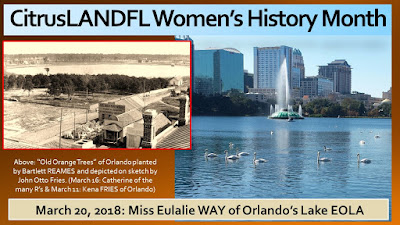The FINALE!
I’ve shared stories of thirty plus remarkable frontierswomen
throughout March, each of whom, in their own unique way, changed the course of
central Florida’s history. Many never made it into history books, with
exception of my books, yet each and every one is certainly deserving of being
remembered. The final spotlight shines on Lucinda and Martha JERNIGAN, daughters
of one of the first area settlers, Aaron JERNIGAN.
Each daughter left a unique mark on local history. Martha
wrote memoirs, painting an excellent picture of how challenging life was for
the earliest of settlers. Lucinda paid the ultimate price for those attempting
to tame a remote Orange County wilderness. Few today realize however that one
#Orlando icon was meant to memorialize HER.
LUCINDA was married in 1858 to merchant George HUGHEY when her
father gave her 160 acres near the newly established village of Orlando. “In
consideration of the sum,” wrote Aaron Jernigan, “of the mutual love and
affection which I have and bear toward my daughter.” Any plans George and
Lucinda might have had for their acreage is not known, as George died later that
year. Lucinda, left with two children ages 2 and 3, married again in 1859. Lucinda’s
second husband was Orlando merchant George W. TERRELL, but within a year, at
age 27, Lucinda (JERNIGAN) Hughey-Terrell died, likely in childbirth.
The lake on her land came to be known as Lake LUCINDY. Lucinda
paid the dreadful price for living in Orange County’s rugged wilderness. A later
developer messed with lake’s name a tad, but Lucinda was indeed the inspiration
for naming Lake LUCERNE. Today, a Lake Lucerne fountain welcomes visitors arriving
from the south.
MARTHA (Jernigan) Tyler was also gifted lakefront land by her
father. Her parcel was on Lake Conway, but Martha’s central Florida’s legacy
remains her memoirs, a telling history of hard times early settlers were forced
to endure. Martha was nine (9) when the families south of Orlando, fearing an
Indian attack was imminent, “fortified” themselves at Fort Gatlin. 67 individuals
represented the population of South Orange County at the time, and Martha’s
detailed account of those families provided the first history about these
courageous settlers.
Martha reported that 17 adults and 50 children were gathered
at the fortress, 50 young Orange County citizens representing the future of
central Florida. I am honored to meet descendants of these brave souls nearly
every time I’m asked to address those who want to hear of the region’s earliest
days.
The history of 19th century central Florida is
packed full of amazing individuals, men and women, all of whom struggled to
overcome a constant bombardment of unimaginable hardships. The history itself
is fascinating, but is made so not merely by events, but rather because of the
character of each participant.
These courageous souls are, and will remain, the main focus of
my historical writings. I hope you have enjoyed this #WomensHistoryMonth series.
I invite you to look over my www.CroninBooks.com website, and please, let me
know your thoughts and comments at Rick@Cronin.Books.com
















